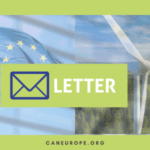To: President Ursula von der Leyen
Cc: Executive Vice-President Frans Timmermans
High climate and biodiversity ambition for Europe’s land under the European Green Deal
On June 9th the European Parliament called for binding Restoration targets and a real effort to bring back nature across the continent. To achieve these objectives policymakers must find an alignment between climate, biodiversity and social objectives and avoid industry concessions through turning land use sectors into a tool to delay Europe’s decarbonisation. We are calling on you to adopt a vision for forests, wetlands, and agricultural land like grasslands and croplands in line with science and the 1.5°C degree target.
The European Climate Law includes provisions to increase the EU net land sink to above 300 million tonnes of CO2 removals by 2030. Many studies have been carried out by researchers looking at the potential of land to sequester carbon within considered sustainability limits and multiple studies suggest Europe can double this ambition. Therefore, civil society groups are calling for the revision of the Land Use Land Use Change and Forestry (LULUCF) Regulation to adopt a net target of 600 million tonnes of carbon removals by 2030 with no offsetting of efforts under the Effort Sharing Regulation (ESR) and the Emission Trading System (ETS).
A higher carbon sink must be pursued with adaptation and biodiversity objectives in mind, which underscores the need to incentivise resilient land-use practices. A variety of win-win actions have been identified to help achieve these objectives including:
-
Close-to-nature forestry practices that reduce harvesting rates
-
A phase-out of support for wood burned as energy
-
Rewetting peatlands to stop the release of carbon counteracting the net LULUCF sink
-
If peatlands are used for agriculture or forestry, they have to be used under wet, not
-
drained conditions
-
Agroforestry for resilient and sustainable food production
That means, future pathways towards emissions reductions and sequestration in the LULUCF sectors should prioritise such actions to ensure the greatest synergies between climate mitigation, biodiversity protection and ecosystem-based adaptation. Such land-use change will not be achieved through carbon trading – in fact a move towards carbon trading could further undermine efforts to value forest and agricultural land beyond carbon and will certainly delay emissions reduction in sectors that must do more.
Not all potential measures are equal for biodiversity and people and are strongly differentiated between regions. The forestry sector must change their management practices – not just plant more trees – to address climate change and biodiversity loss. Drainage-based peatland management needs to phase out during this decade and large-scale rewetting has to take place to reduce greenhouse gas emissions from the largest source in the LULUCF sector. If peatland needs to be used, only wet uses like paludiculture should be applied.
Considering this, the revised legislation must ensure that concrete links will be drawn between the LULUCF Regulation and the European Union biodiversity objectives, including those set out in the European Union Biodiversity Strategy: mainly the EU Restoration Law, the EU Forest Strategy, and the Birds and Habitats Directive. In order to support and emphasise the synergy between efforts to improve climate and biodiversity the revision of the LULUCF regulation should include a system to measure and report the quality of carbon stocks.
The LULUCF revision is an important opportunity to reverse the current impact of land degradation across Europe. This requires that climate ambition is supported with transformative land-use practices and with strong consideration for nature and biodiversity. We count on your support to restore Europe’s lands.
Thank you for your consideration,
Wendel Trio
Director Climate Action Network Europe




